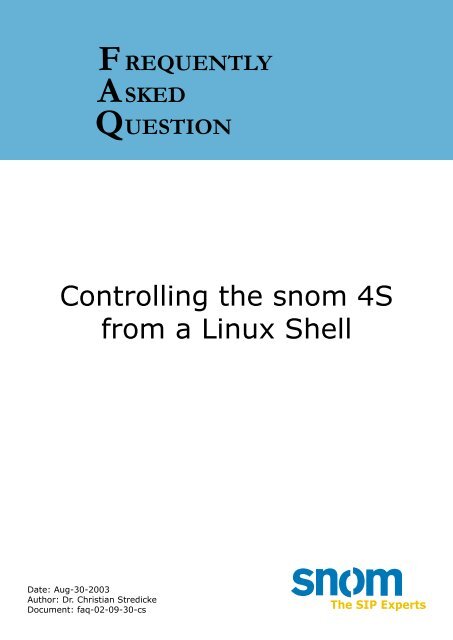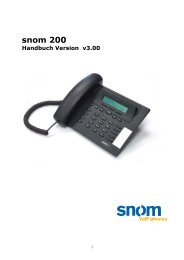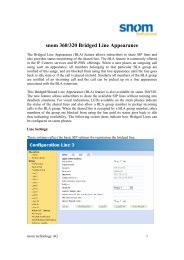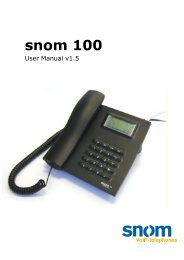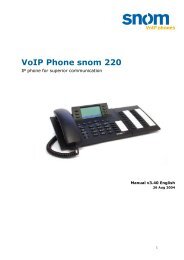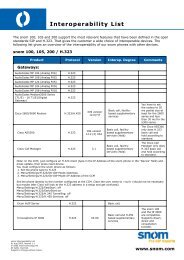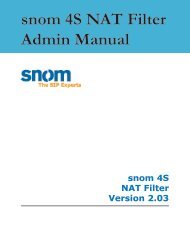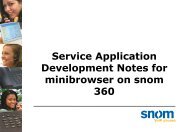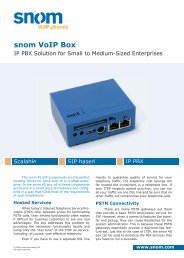F REQUENTLY A SKED Q UESTION - Snom
F REQUENTLY A SKED Q UESTION - Snom
F REQUENTLY A SKED Q UESTION - Snom
You also want an ePaper? Increase the reach of your titles
YUMPU automatically turns print PDFs into web optimized ePapers that Google loves.
F <strong>REQUENTLY</strong><br />
A <strong>SKED</strong><br />
Q <strong>UESTION</strong><br />
Controlling the snom 4S<br />
Date: Aug-30-2003<br />
Author: Dr. Christian Stredicke<br />
Document: faq-02-09-30-cs<br />
from a Linux Shell
Problem Statement<br />
In some environments, users of the<br />
snom 4S would like to be able to automatically<br />
perform actions such as registering new users<br />
and deactivating accounts. In principle, these<br />
actions are not critical to performance.<br />
The snom 4S software components have<br />
a built-in web server that supports the features<br />
required. It therefore makes sense to have a<br />
“remote control” that uses the web interface<br />
of the Proxy or the Media Server in the same<br />
fashion as real users do. The snom 4S does<br />
not recognize that a shell script controls its<br />
behavior.<br />
Initiating Web Access from the<br />
Command Line Interface<br />
The problem of controlling a remote web<br />
server from a shell is well known. There are<br />
programs available for performing this task -<br />
“curl” is available for Linux and for Windows<br />
and can be integrated into shell scripts and<br />
PHP programs. For more information, see<br />
http://curl.haxx.se. Other web programs work<br />
in a similar way.<br />
The proxy and the media server do not<br />
differentiate between POST and GET with<br />
parameters in the URL.<br />
Parameter values are “url-encoded”. That<br />
means that some special characters have a<br />
particular meaning. For instance, the “&” is<br />
a separator symbol between the parameters,<br />
the “+” means a space character and “=” is<br />
used to indicate an assignment of a value to<br />
a variable. If you want to encode one of these<br />
special characters (and other characters that<br />
are not in the normal character set), you can<br />
use the % followed by the two-digit hex code<br />
of the character to encode the character that<br />
you need. If in doubt, you should use the %xx<br />
notation.<br />
[ F R E Q U E N T L Y A S K E D Q U E S T I O N ]<br />
Proxy Version 2.3x and Higher<br />
In the 3.x versions of the proxy, we use<br />
a scripting language to control the behavior of<br />
the proxy. When the proxy receives a request<br />
to post information to a predefined webpage<br />
(post.htm), it first determines the domain<br />
and the password for this domain. If there is<br />
a match, it sets all variables in the http post<br />
accordingly and calls the subroutine “on_post”.<br />
This function can then perform the necessary<br />
actions (a predefined behavior is available,<br />
see below). Sending information to the proxy<br />
does not require a session context.<br />
For example, if you use “curl http://<br />
myproxy:8080/post.htm?domain=abc.com&p<br />
ass=secret&var1=abc&var2=hello+here%21”<br />
, the proxy will execute the function “on_post”<br />
in the domain context of “abc.com” (if it exists<br />
and the password is “secret”). The variable<br />
“$var1” will be set to “abc” and the variable<br />
“$var2” will be set to “hello here!”.<br />
The Default on_post() Function<br />
The proxy comes with several predefined<br />
default functions. If you load another on_<br />
post() function in the domain, these functions<br />
are overwritten.<br />
The default script uses the variable<br />
“action” to indicate what the proxy should do.<br />
• create_user:<br />
This function uses the variables<br />
“account” (which indicates the account to<br />
use), “username” (which indicates the user<br />
name for challenging) and “password” (the<br />
password for challenging) to create or update<br />
a user account.<br />
• delete_user:<br />
This function deletes a user account<br />
(indicated in the variable “account”).<br />
• disable_user:<br />
This function disables a user account<br />
(indicated in the variable “account”).<br />
• enable_user:<br />
2 snom technology AG
This function enables a user account<br />
(indicated in the variable “account”).<br />
Available Actions for the Proxy<br />
Versions 2.2x<br />
We highly recommend upgrading to<br />
proxy versions 2.3x or higher. However, if<br />
you do wish to continue operating the 2.2x<br />
or previous versions, you will need to use a<br />
different web interface.<br />
You can take a look at the html source<br />
code before pressing the “save” button to a<br />
web request in order to see which parameters<br />
are used to post a request. This chapter shows<br />
and explains to you which parameters are<br />
valid.<br />
Setting Parameters in 2.2x<br />
Setting parameters is carried out with<br />
the SAVE=Save parameter. The table on<br />
the next page shows which parameters are<br />
available (also see the manual). For example,<br />
to set the retry_t1 time, you would use:<br />
curl -d save=save -d retry_t1=400 -u<br />
user:pass myproxy.com:5068 >/dev/null<br />
Add a User<br />
To add a user, use the parameters<br />
Domain, Account, Username and Password<br />
as described in the snom 4S Proxy/Registrar<br />
manual and add the ADD_USER=Add/Edit<br />
parameter.<br />
Example to add a new user:<br />
curl -u user:pass -d ADD_USER=add/<br />
edit -d domain=bla.com -d account=testc<br />
-d username=testc -d password=1234<br />
myproxy.com:5068 >/dev/null<br />
Remove a User in 2.2x<br />
To remove a user, set the argument<br />
userdel to the account name of the user you<br />
want to remove. No additional parameters are<br />
required. Make sure that the domain name is<br />
[ F R E Q U E N T L Y A S K E D Q U E S T I O N ]<br />
separated from the user name by a space.<br />
Example:<br />
curl -d userdel=”bla.com testc” -u user:<br />
pass myproxy.com:5068 >/dev/null<br />
Add a Dial Plan Element in 2.2x<br />
Adding an element to the Dial Plan<br />
is similar to adding a user. The parameter<br />
SaveAdr must be set to Save.<br />
The values for the dial plan are stored<br />
in the variables apa[x], apb[x], apc[x] and<br />
apd[x]. x starts from 0 for the first entry and<br />
continues until a empty line has been found.<br />
apa elements may have the value allow,<br />
deny, incomplete, gateway or notfound<br />
according to the meaning described in the<br />
manual. apb, apc and apd have the values<br />
described in the manual.<br />
Add Error-Info Element in 2.2x<br />
The error-information list is handled in a<br />
similar fashion to the dial plan.<br />
The variables manipulated here have the<br />
name eia[x] and eib[x]. eia takes the error<br />
code (e.g. 404), eib the destination url.<br />
Parameters for 2.2x<br />
The following list shows the available<br />
parameters:<br />
Remote Control for snom 4S 3
[ F R E Q U E N T L Y A S K E D Q U E S T I O N ]<br />
sip_port_number: The SIP port number.<br />
nat_proxy: The address of the NAT gateway<br />
save_registration: True or false if the registration should be saved.<br />
hostname: The list of the hostnames.<br />
config_file: The name of the config file.<br />
min_regtime, max_regtime: Minimum and maximum registration time.<br />
default_q: The default q value.<br />
log_register: True or false if REGISTER should go into the SIP message<br />
trace.<br />
seqfork_delay: The delay for sequential forking.<br />
reg_dir: The directory for storing the registrations.<br />
log_filename: The filename for logging.<br />
log_level: The log level.<br />
max_forwards: The maximum number of SIP message forwards.<br />
tcp_threshold: The TCP threshold.<br />
retry_t1: The retry timeout T1.<br />
timeout_408: The timeout value for responding with 408 No Response.<br />
call_log_length: The length of the call log.<br />
auth_realm: The realm for authentication.<br />
force_authorization: True or false if authorization should be forced.<br />
auth_exception: The exception pattern for the authentication.<br />
html_port_number: The number for the http port.<br />
pw_pass1, pw_pass2: The password for the web interface (including<br />
confirmation).<br />
pw_user: The username for the web interface.<br />
allow_pattern: The allow pattern in encoded form.<br />
license_code: The license code.<br />
error_info: A pattern for generating the error-information headers.<br />
reject_nat_register: True or false if NAT registrations should be rejected.<br />
no_loose_routing: True or false if loose routing should be turned off.<br />
no_route_on_record_route: True or false if no route should be carried out if record-<br />
route is already present.<br />
callog_filename: The name of the call log file.<br />
dirty_host_ttl: The time to live to dirty host detections.<br />
welcome_event: The name of the welcome event.<br />
welcome_type: The type of the welcome event.<br />
welcome_file: The file for the welcome event.<br />
welcome_method: The method used for the welcome event (MESSAGE or<br />
NOTIFY).<br />
no_tags_on_18x: True or false if tags in 18x codes should be removed.<br />
Posting to the media server<br />
You should keep as little database<br />
information as possible on the media server.<br />
The newer versions of the media server<br />
allow for example the automatic setup of<br />
mailbox accounts, which reduces the need for<br />
automatic access to the media server.<br />
However, if you need to post to the media<br />
server, you can do this in the same way as<br />
posting to the 2.2x proxy. The media server<br />
does not have the concept of a domain and<br />
uses basic authentication for checking the<br />
user credentials.<br />
For example, if you want to set up a new<br />
calling card account, you would use “curl -u<br />
user:pass -d savecc=save -d cc_account=cc<br />
-d cc_number=1234567890 -d cc_code=1234<br />
-d cc_credit=1000 mediaserver.com:8080 >/<br />
dev/null”<br />
Security<br />
Currently, the proxy uses only plain http to<br />
exchange the data. Future releases will allow<br />
privacy by using https as transport layers.<br />
4 snom technology AG
Europe & ROW:<br />
snom technology AG<br />
Pascalstr. 10B<br />
10587 Berlin, Germany<br />
Phone: +49 (30) 39833-0<br />
mailto:info@snom.de<br />
http://www.snom.com<br />
sip:info@snom.com<br />
© 2003 snom technology AG<br />
All rights reserved.<br />
USA and Americas:<br />
snom USA Representation<br />
ABP International, Inc.<br />
1203 Crestside Dr.<br />
Coppell, Texas 75019, USA<br />
Phone: +1-972-831-0280<br />
mailto:usa@snom.de<br />
sip:usa@snom.com<br />
India and SAARC:<br />
snom technology (India) Pvt Ltd.<br />
No. 417, International Trade Tower<br />
Nehru Place, New Delhi-110019<br />
Phone: +91 11 26234097<br />
Fax: +91 11 26234079<br />
http://www.snomindia.com<br />
mailto:info@snomindia.com<br />
sip:india@snom.com


